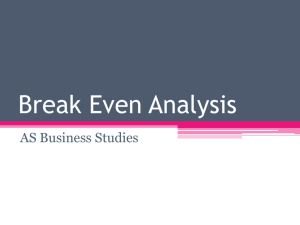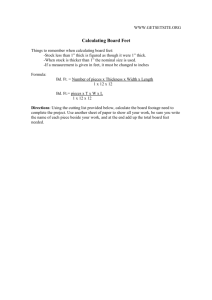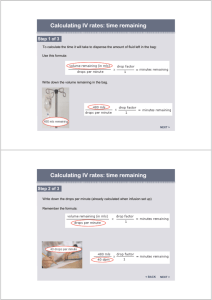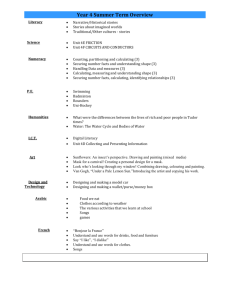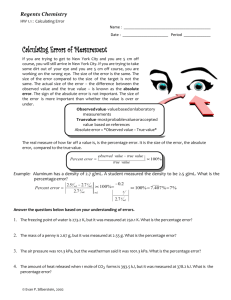CHAPTER 9
advertisement
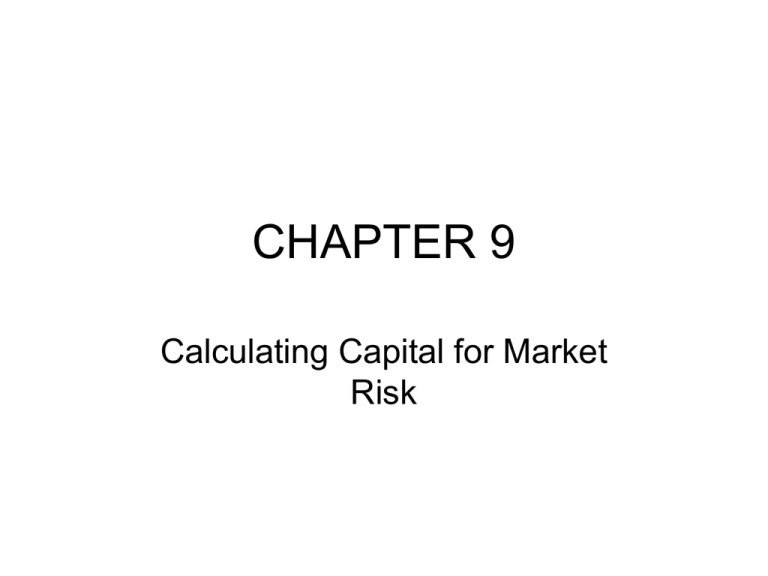
CHAPTER 9 Calculating Capital for Market Risk INTRODUCTION • VaR gives a solid foundation for assessing the amount of capital that should be held by a bank to protect it in the case of losses arising from market risks • There are three reasons for analyzing the capital consumed by market risks – Complying with industry regulations – Calculating economic capital to control the bank's default probability – Measuring Risk-Adjusted Profitability COMPLYING WITH INDUSTRY REGULATIONS • In 1996, the Basel Committee on Banking Supervision recommended to national regulators that the minimum capital to be set aside for market risks should be based on VaR. • The regulatory capital should equal the 99% 1-day VaR, multiplied by 3, times the square root of 10: • (Regulatory) Capital =3x 100.5 x VaR99% COMPLYING WITH INDUSTRY REGULATIONS • The square root of 10 represents the losses that could occur over a 10-day holding period – if there was a 10-day crisis in which the markets became illiquid. • The factor of 3 allows 3 such events to happen each year • If the back-testing shows an unusual number of exceptions, the capital should be increased according to Table 8-2 in the previous chapter • In calculating the VaR, each bank is allowed to use whatever method it thinks will best pass the back-test. CALCULATING ECONOMIC CAPITAL TO CONTROL THEBANK'S DEFAULT PROBABILITY • To be allowed to stay in business by the regulators, banks must hold at least the capital discussed above • However, if banks wish to maintain a high credit rating and a low probability of default, they may wish to hold more capital • This amount is calculated using the Economic Capital framework CALCULATING ECONOMIC CAPITAL TO CONTROL THEBANK'S DEFAULT PROBABILITY (1)the maximum probable loss such that there is only probability p that the profitability over a year will be worse than wp (2) p = probability [profit < Wp] Discount value from one year later CALCULATING ECONOMIC CAPITAL TO CONTROL THEBANK'S DEFAULT PROBABILITY • VaR gives us the maximum probable loss that could happen with a 1% probability over one day • To get the economic capital, we need to translate – from 1% to the required confidence level – from one day to one year CALCULATING ECONOMIC CAPITAL TO CONTROL THEBANK'S DEFAULT PROBABILITY • If we assume that the losses are Normally distributed, then if a bank held capital equal to 2.32 times the standard deviation of the possible annual losses, there would be a 1% chance that the actual loss over 1 year would exceed the capital • If the bank held capital equal to 3.7 times the standard deviation of losses, there would only be a 0.01% chance that the actual loss would exceed the capital – The bank could therefore expect to be rated AA or AAA • Table 9-1 gives the relationship between the amount of capital that a bank holds against market risks and the consequent probability that the actual losses would be greater than the capital CALCULATING ECONOMIC CAPITAL TO CONTROL THEBANK'S DEFAULT PROBABILITY CALCULATING ECONOMIC CAPITAL TO CONTROL THEBANK'S DEFAULT PROBABILITY • Typically, A-rated institutions have a default probability of around 0.1% • From Table 9-1, we can say that an Arated institution should aim to hold capital equal to 3.1 times the standard deviation of the potential annual change in value (assuming a Normal distribution) • Economic Capital A = 3.1 xσ1year CALCULATING ECONOMIC CAPITAL TO CONTROL THE BANK'S DEFAULT PROBABILITY CALCULATING ECONOMIC CAPITAL TO CONTROL THEBANK'S DEFAULT PROBABILITY • This is more than twice as high as the regulatory capital • One reason for the discrepancy is that banks may wish to be more creditworthy than is implied by the minimum regulatory capital • Another reason is that the regulatory capital implicitly includes a reduction due to diversification between market risks and the other risks in the bank • A further reason is that we assumed that the standard deviation of losses scales with the square root of time. This assumption breaks down for two reasons – The first is that over long periods, such as a year, effects such as mean reversions manifest themselves. – The second reason is that it assumes that the trader holds a fixed position all year and takes whatever losses the market brings. With the trader's skill, and with bank's policies to stop losses, this should not be the case. CALCULATING ECONOMIC CAPITAL TO CONTROL THEBANK'S DEFAULT PROBABILITY • in general, the required economic capital for an A rating was found to be between one and two times the minimum regulatory capital • Once the capital has been established for the portfolio as a whole, it can be allocated to the individual traders, subportfolios, transactions, or desks, using the VaRC methodology • The capital allocated to an individual transaction is the VaRC for the transaction, divided by the VaR for the whole portfolio, and multiplied by the capital for the whole portfolio: MEASURING RISK-ADJUSTED PROFITABILITY • Once we know the capital being consumed by a particular transaction, we can calculate the RiskAdjusted Return on Capital (RAROC) and the Shareholder Value Added (SVA) • Knowing the risk-adjusted performance, we can properly decide on whether the profit from a transaction is worth the risk and whether a trader is performing well or just risking a lot of the bank's capital • The RAROC is simply the net income from the transaction divided by the capital consumed MEASURING RISK-ADJUSTED PROFITABILITY If the transaction only lasts a few days (T) and only requires capital for that time, the calculated RAROC should be annualized so that it can be compared with the RAROC from other transactions MEASURING RISK-ADJUSTED PROFITABILITY • The hurdle income is the amount of capital consumed multiplied by the hurdle rate that the shareholders require as a minimum return for risking their capital • The hurdle rate HT, for a short-term transaction lasting T days can be calculated from annual hurdle rate, HAnnual MEASURING RISK-ADJUSTED PROFITABILITY • The required income is then the capital consumed multiplied by HT: – Required Income = Allocated Capital x HT • The SVA is then the net income minus the required income – SVA = Net Income — Allocated Capital x HT
